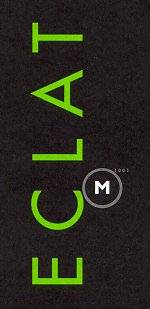
In a polemical introduction to the programme book for his fourth Eclat
Festival of new Music in Stuttgart, Hans-Peter Jahn, moving
spirit and Artistic Director since its inception, expresses his reservations
about trying to explain music in words, warning readers that this programme
is not salvation with commentary. His comments are quoted here at some
length, because they have wisdom and also an obvious bearing upon the endeavours
of Music on the Web and
Seen&Heard.
Jahn goes on, in Biblical vein, to promise seekers of salvation that "They - i.e. 'those who grasp for words to express what music is saying, and feel a need to pin down and archive experience', - shall be helped", but he goes on to caution ' what I read is not what the sound is like, therefore what I write is not what the listener will hear' - - 'writing about music could be perhaps a kind of mountain guide, without the risk of falling off or crashing down, a rope for the uninitiated beginner, a straw of information embedded in the middle of a mighty granite rock ' (i.e. the music itself). He quotes with some scepticism a further thought which he had read - 'Those in Germany who do not have the Internet belong to the underprivileged class ', and he goes on to dedicate the Eclat programme book 'to the underprivileged'!
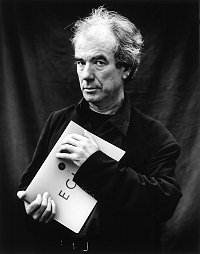
Last year I had discussed with Jahn
[right] (a constant presence
at the Theaterhaus and a delightful man to meet and talk with, welcoming
and always willing to share his thoughts) the difficulty faced by critics
from abroad when deprived of the usual assistance by way of commentaries
on the works to be given. This year he purported to help, but the content
of the programme book (and also the short pre-concert talks) avoided once
again any analysis of the music or statements of the composers' intents.
There were additional perversities such as the darkened auditoria which made
it far from easy to locate the factual information scattered through the
programme book, the peculiar pagination of which resulted in one's often
coming across the text of a vocal work after the performance, finding it
buried pages further on, after the listings and note of a later concert.
For the Stuttgart public, in only four short years Jahn's policy of encouraging people to just come, listen and trust their own ears has proved a triumphant success. He takes pride in having established a loyal audience which is unafraid of the new and unknown, which travels to an adapted disused former glass factory at the outskirts of Stuttgart and packs a large auditorium to the rafters to hear music at the extreme 'cutting edge' of modernity. The Theaterhaus at Wangen is not obviously an appealing venue, but it has proved ideally suitable for this event, being well endowed with different sized auditoria, and ample spaces for meeting, eating and drinking. Prominent notices facing us at the end of our platform on arrival at the main railway station announced the importance of the Eclat festival in Stuttgart's cultural calendar; imagine a contemporary music festival being advertised at Kings Cross Station in London!
Eclat 2001 began in a relaxed way with a Children's Theatre collaboration between John Cedric Brown, a composer from Vancouver with a special interest in the worlds of magic and circus (described in the programme as a Canadian Giacinto Scelsi, because of his use of 'long duration microtonal fields') and an amazing illusionist, Roland Schopp, who did impossible tricks in a rapid series of disguises, supported by a quartet of harp, accordion, tuba and a flamboyant whooping counter-tenor, Daniel Gloger.
The first evening concert featured the superlative SWR Volkalensemble
Stuttgart , a mainstay throughout the four days. In Tempus Cadendi-Tempus
Sperandi , completed last year by the veteran Swiss composer Jaques
Wildberger (b.1922) to Holderlin poems, the choir was supported
by sensuous sonorities produced by a quartet of percussion and keyboard;
a choral setting which looked back perhaps to the 60s & 70s, but was
none the worse for that. Blumenstuck to texts by Jean Paul by the
Austrian
Georg
Friedrich Haas (b.1953, now living in Ireland) for choir
supported by string quintet & bass tuba, took us to the interval.
It seemed to comprise an enervating procession of slow, separate chords,
suspensions with resolution infinitely denied, and having something of the
ponderousness of the later Gorecki. (But more about Haas later - and see
also
S&H
review from John Warnaby )
To our ears, best by far in the lengthy first half, and briefest, was the young Japanese composer Misato Mochizuki's 11 minutes race through her virtuosic instrumental Chimera (previously noted by S&H at Witten) for a London Sinfonietta type ensemble of three strings, bass clarinet, saxophones, trumpet & trombone, 3 percussionists and piano, its complexity dismissed perfunctorily to end with an irreverent fart! Too much to take in or describe at a single hearing, I look forward to encountering Chimera again.
Most composers were represented by single works, but Éclat 2001 offered a retrospective for the Greek specialist in Musiktheater, Georges Aperghis (b.1945). This first concert was overlong by any reckoning, its duration extended by lengthy platform re-arrangements, and Aperghis's 70 minute Hamlet Machine (which apparently relates to an opera by Rihm with the same title) took us to 11 p.m, which may have worked against it. This grandiose Oratorio for actors, choir and alto solo, with percussion soloist and instrumental ensemble had a text by Heiner Müller, of which no sense could be made out, and we found ourselves equally out of sympathy later in the week during Re-Citations (Das Musiktheater von Georges Aperghis), an event comprising six of his musiktheater pieces dating from 1945 to 1980, plus new ones in similar vein by Wilhelm Killmayer and Nicola Santi. The heavy humour, based mostly on the well worn theme of communication and its failure, was of a type which had been expressed with more wit by Kagel and, for example, in Ligeti's Aventures. (Following the SWR broadcasts from Eclat 2001, to be transmitted fortnightly from 27 February, S&H hopes to publish a further report of the festival, which may do better justice to Aperghis.)
Guitars and guitar duos are increasingly to be met with in contemporary music festivals and Wilhelm Bruck & Theodor Ross have built up a reputation together in Germany, with premieres of Zimmermann, Kagel & Lachenmann to their credit. Although there were few normal sounds to be heard in their music theatrical performance, there was no reason to doubt their skills. Both works were capable of various possible interpretations.
Kurze Schnitte (41 pieces for two guitarists) by Uwe Kremp (b.1964) had the duo discarding each page onto the floor, their musical efforts very much related to how Lachenmann analyses and breaks down all the latent sounds of an instrument - familiar accidental noises combined to create elements of an entirely new sound spectrum. The 82 pages of musical fragments were later gathered up by an actress, Susanne Schyns, and were connected and given continuity in time through this enigmatic woman, whose actions counterpointed the playing, paradoxically seeming unable to connect with the music as she moved around and between the players, almost like a deaf person, intrigued by the musicians and their unfathomable activity. Finally she ascended a ladder and showered the pages down onto the floor again. Music (or was it contemporary art music) seemed to have no meaning for her - or (by extension) for most other people?
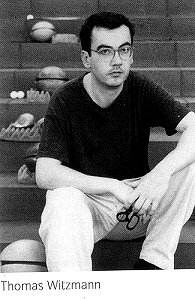
For the second half of Wilhelm Bruck & Theodor Ross's event,
Thomas Witzman (b.1958) supplied Wanderlust (the pleasure of
rambling) a piece of musical theatre of mesmerising intensity. To this writer
it became quickly apparent that the title is ironical and not a reference
to an idyllic country walk. Four guitars lie on the floor spotlit in
semi-darkness, another two dangle either side of the row like hanged creatures.
Sinister presagings are re-inforced with guitars suddenly, unceremoniously
and noisily dropping down from scaffolding high above the auditorium, where
we eventually locate the source of some grating sounds. Heavy booted players
wend their ways precariously along the walkways in the flies, clanking their
instruments which then get dragged down the stairs through the audience.
Each movement and surface contact is earily amplified by floor microphones.
The wanderers at first move around in a seemingly aimless fashion, strumming
their instruments and every now and then taking a swipe at the 'victims'
to send them spinning around. A confrontational situation develops over the
occupation of a wooden stool. Aggressive attacking noises climax in a drawn
sword duel, with guitars clashing head on, grating each others' strings
uncomfortably. The fight over territory ends with the winner expropriating
the other player's guitar.
The allusions to a war situation are reinforced, with the guitars at one point becoming crutches or a false leg for bent-over cripples. A disemboweling scene has the players drawing an enormous length of wire from the belly of a 'victim' instrument. They then send frenzied shock waves along this wire, stretched across the width of the auditorium, eventually attacking the vulnerable guitars lying on the floor. Those, in turn, try some resistance, attempting to get up, only to crash down 'dead' in the end. Worse was to come, with a mother and child ( one overlarge and one tiny guitar) being shot to pieces with darts till they keeled over.
The sense of the monstrosity, vandalism and the destructiveness unleashed with the soundscape and the visual picture which was enacted was utterly harrowing and made one gasp. This is gripping and thought provoking music theatre. A great work.
In the penultimate Sunday afternoon concert two pieces commanded our attention. The String Quartet no.2 of Georg Friedrich Haas, premiered in Vienna by the Hagen Quartet, underlined for us the danger of rushing to judge any composer upon a single work. With a tonal basis discernible not far in the background, its main sonic constituent was sustained music with microtonal inflections, harmonics and glissandi upwards and downwards, punctuated by occasional arpeggiated halos and, in complete contrast, rough dramatic interruptions. Inevitably the influence of Scelsi was felt strongly here again (see his name mentioned in the first event) and the composer has confirmed that he is an aficionado of that mid-50s avant-gardist. This was music which made its effect in a very direct way, the procedures being evident to the ear, trained or not.
A rock-based composition by the Swede Dror Feiler (b.1951) pitted two pianos in unequal battle against a battery of sustained fury launched by two percussionists, mainly on two bass drums and high metallic glockenspiel, which easily absorbed the complex music visibly, but almost inaudibly, being produced by two valiant pianists. That was not wholly unintentional; we were advised that complex patterns were trying in vain to assert themselves behind the brutish wall of sound. Audience reaction was divided; several walked out during the onslaught. It never ceases to surprise how puny two Steinways can sound when ill-matched by a composer who may have in mind engineered balance (c.p. the two piano concerto of Jose Manuel Lopez Lopez as heard at Strasbourg). For the live audience, this piano & percussion quartet should have amplified their pianos, as they do on the group's CD for George Crumb's Makrokosmos III ( Berio, Crumb & Dieter Mack - SDR Audite 97.455) All will be well, for sure, in the broadcast on 10 April.
The final concert in this fourth year of the Eclat festival in Stuttgart paid tribute to Boulez with a sprightly account of his seminal Éclat by Stuttgart's new music ensemble Varianti, under the amiable and expert leadership of Manfred Schreier. Hans-Peter Jahn likened its free, but also strictly fixed, writing to the quality he seeks for the festival as a whole - a coming together of coherent & not so coherent compositional decisions which create explosions of brilliance, bringing light into the musical substance of all the works given in the festival. Three young composers, awarded Stuttgart City Prizes which they shared equally, had their works played. None was world-shaking. I found Christian Utz's inclusion of shakuhachi & pi-pa in the ensemble for Kreise-Yuan insufficiently integrated, reminiscent of 19C orientalism in visual art. Bruno Mantovani's oddly titled Turbulences for twelve instruments was an enjoyable exercise in saturated romantic sound, everyone getting his turn to shine, the whole decorated with swirling trills and arabesques; nothing at all radical here (it was previously suggested to me that my liking for the violin concerto played a few days earlier betrayed an 'English' aesthetic sensibility, and the same might apply again here?).
The only British work heard during the festival was Cinnabar by the well-established composer Rebecca Saunders, now living in Berlin. It was a double concerto for violin and trumpet, with percussion prominent in the ensemble. To me it was hard edged, radical and interesting. Both violinist and trumpeter were confined to limited gestures - the violinist's left hand was constrained and not allowed to roam around the finger board; the trumpeter was mainly occupied swapping around a collection of mutes, whilst some odd percussion instruments responded to their frenetic and frustrated activity. It ended with the tinkling of two musical boxes; one listener told me she liked the piece particularly for being 'so feminine' - how individual and irreconcilable are different people's responses to contemporary music!
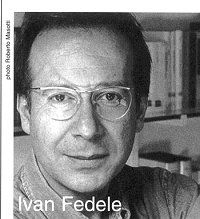
The most important new work in this concert, and arguably in the festival,
was Animus/anima by Ivan Fedele (b. 1953), a major composer
from Italy of whom I only became aware belatedly last year through his two
CDs, which I have been playing through again and again. A substantial and
complex unaccompanied work for seven solo singers, being premiered by members
of the Neue Vocalsolisten Stuttgart, it falls into four sections
Incipit, Eros, Vox and Anghelos which explore highly differentiated
possibilities of homophonic and contrapuntal vocal music. Repetitive at first,
after a short time the repetitions are blown apart and give way to narrowest
contrapuntal fragmentation, before regrouping into similar or completely
new homophonic fields. Very demanding of the highest vocal and ensemble skills,
this was presented in an interpretation which pleased the composer, going
far beyond unravelling of the score.
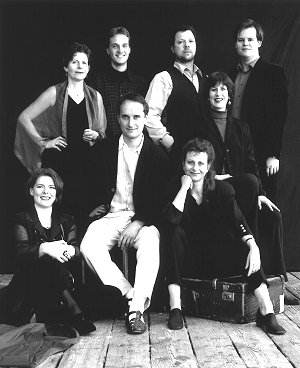
There are two CDs available of music by Fedele, including a piano concerto
with Bruno Canino as soloist
Stradivarius
STR 33348 *****. A CD of the Stuttgart performance of
Animus/anima (which will be broadcast by SWR2 on 24 April) would be
particularly welcome, possibly coupled with a forthcoming Flute Concerto
by Fedele due from
Mario
Caroli? Thomas Witzman's unusual quirky individuality can
be enjoyed from his percussion CD Zeug für Schlagquartett
Random Acoustics RA 024 ****.
Following Eclat, Witzmann was returning toUK for a second time to conduct
a Workshop and Performance at the Glasgow School of Art (Musik und Architektur);
for his CD, visit
http://www.witzmann.com
The Neue Vocalsolisten Stuttgart has two CDs from previous Musik der Jahrhunderte Eclat festivals, which give a good impression of their unique qualities; details from office@musik-der-jahrhunderte.de.
All the concerts of Eclat 2001 are scheduled to be broadcast on SWR2 on Tuesdays at 19.05 continental time, fortnightly from 27 February to 10 April, and on 5 June.
Peter and Alexa Woolf
 Return to:
Return to: